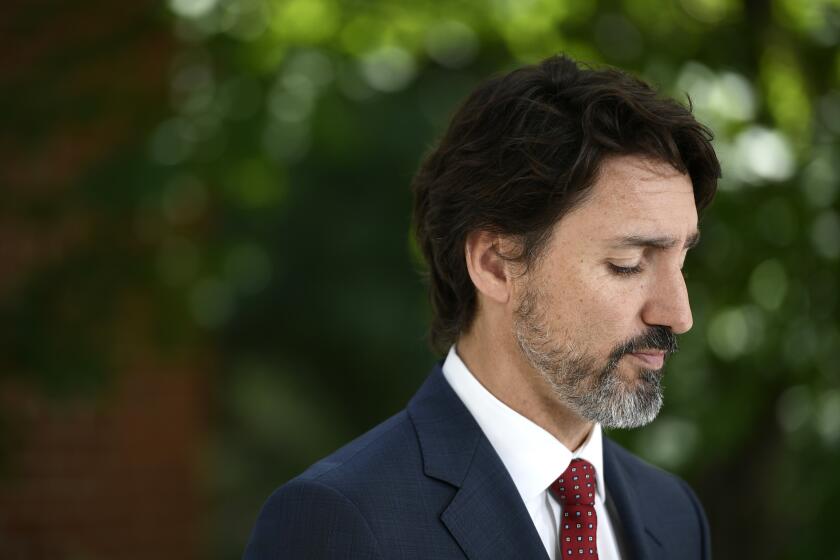Iran’s nuclear program has slowed almost to a halt, IAEA says
WASHINGTON — Iran’s new government has slowed expansion of its nuclear program almost to a halt since August, according to the United Nations nuclear watchdog agency, in what experts view as a strong signal of Tehran’s desire to resolve a decade-long diplomatic standoff.
A report released Thursday by the Vienna-based International Atomic Energy Agency provides the first independent evidence that President Hassan Rouhani, who was elected in June after promising to end the crisis, has essentially stopped new work at Iran’s nuclear facilities, including enrichment of uranium and construction of the heavy-water reactor at Arak.
The previously unreported freeze may bolster the Obama administration and others in the six-nation diplomatic bloc hoping to persuade Tehran to give up its nuclear drive for good. The two sides are scheduled to resume negotiations Wednesday in Geneva.
Three days of talks in Geneva last week nearly produced an interim deal in which the West would suspend some economic sanctions and Iran would stop some nuclear work to buy time for negotiations aimed at forging a final deal. But the proposal drew heavy fire from hawks in Congress, Israel and parts of the Arab world who insisted the West should add more pressure, not less, to force concessions from Iran.
In a news conference Thursday at the White House, President Obama urged Congress not to impose more economic sanctions that could kill a diplomatic deal. Although he insisted a military option remains “on the table,” Obama expressed clear reservations about attacking Iran, warning that no one could predict the outcome of another U.S. war in the Middle East.
“No matter how good our military is, military options are always messy, are always difficult, always have unintended consequences, and in this situation never complete in terms of making us certain that they don’t then go out and pursue even more vigorously nuclear weapons in the future,” Obama said.
With sanctions slowly strangling Iran’s oil-based economy, Rouhani and his top aides have declared their eagerness to do a deal and thaw long-frozen relations with the West. The IAEA report, which reflects developments in Iran since Aug. 28, provides a measure of tangible reassurance that Rouhani is serious, analysts said.
“It’s a signal that Iran’s more willing to be flexible on the issue,” said Alireza Nader, a Middle East specialist at Rand Corp. “It’s a positive sign.”
The report shows that Iran has installed none of the new advanced IR2M centrifuges, which can produce enriched uranium five times faster than earlier models, at its Natanz facility. Nor is Iran using any of the IR2Ms it had installed. It added only four of the older centrifuges to its arrays, bringing the total to 15,240.
Iran added 10 kilograms of medium-enriched uranium to its stockpile, the report says. The total, 196 kilograms, is well below the roughly 250 kilograms needed to create fissile fuel for a nuclear bomb.
At Arak, the inspectors found evidence that technicians had connected the reactor vessel to piping. But they said no other major components, such as control room equipment, the refueling machine and reactor cooling pumps, had been installed.
This week, Iran signed an agreement with the IAEA to allow inspectors expanded access to several nuclear sites that have not been fully monitored, including the Arak facility and a uranium mine.
But Iran continued to deny the IAEA full access to the Parchin military site near Tehran, where inspectors suspect Iran may have experimented with nuclear weapon triggers.
The dispute over Parchin is one reason many countries fear Iran is seeking a nuclear weapons capability. Iran insists its nuclear program is only for energy and other peaceful purposes.
Israeli Prime Minister Benjamin Netanyahu, who sharply criticized the proposed interim deal in Geneva last weekend, said Thursday that he is “not impressed” by the IAEA report. Iran has sufficient assets to reach a nuclear weapons capability even without new centrifuges or other equipment, he said.
The White House wants to dissuade Congress from adopting new sanctions that could drive Iran from the negotiating table, or unravel the coalition of nations that has agreed to cut trade with Iran. Vice President Joe Biden, Secretary of State John F. Kerry and other top officials went to Capitol Hill on Wednesday to make their case to lawmakers who have pushed for more penalties.
At his news conference, Obama said the trade-offs in the interim deal would provide a six-month window to test whether Iran was serious about curbing its nuclear program. If Iran failed that test, he said, the full range of sanctions “can be ramped back up.”
Obama defended the effort to stop Iran in stages, saying, “It has never been realistic that we would resolve the entire program at once.”
The deal under consideration in Geneva would “halt advances” in the nuclear program, neutralize some of the enriched uranium and impose more vigorous IAEA inspections. It also would buy “some additional months” in case Iran ultimately decided to seek a nuclear bomb, a goal Obama vowed to prevent.
“Let’s test how willing they are to actually resolve this peacefully and diplomatically,” he said. “We will have lost nothing at the end of the day if it turns out that they are not prepared to provide the international community the hard proof and assurances necessary for us to know that they’re not pursuing a nuclear weapon.”
[For the record, 6 p.m.: A previous version of this article said Iranian President Hassan Rouhani was elected in July. He was elected in June.]
More to Read
Sign up for Essential California
The most important California stories and recommendations in your inbox every morning.
You may occasionally receive promotional content from the Los Angeles Times.











